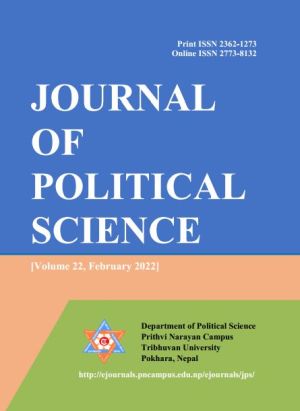Disarming Khampa Guerrillas by the Nepal Government: A Politico-Historical Perspective
DOI:
https://doi.org/10.3126/jps.v22i1.43035Keywords:
Khampa guerillas, refugee, Tibet, Dalai Lama, bilateral treaty, disarmamentAbstract
After the end of the Second World War, Mao Zedong managed to drive Chiang Kai-Shek to Taiwan in October 1949. Mao decided to annex Tibet, a soft under-belly of China, by exercising the Chinese suzerain rights. On 17 March 1959, after the 14th Dalai Lama fled to India, Tibet was incorporated into the People's Republic of China (PRC). The erstwhile Nepal-Tibet border remained open and abandoned from the Nepali security perspective as thousands of Tibetans sought refuge in Nepal during the annexation of Tibet. Ultimately, the Tibetan refugees (Khampas) were militarily trained and financially assisted by the foreign powers to establish operational bases in the remote stretches of Northern Nepal and wage the protracted war against the PLA to regain their lost motherland. Nepal still maintains a non-aligned foreign policy and is staunchly against harboring elements that engage against the security interests of its two neighbors. Hence, the Government of Nepal had to stop such detrimental activities resolutely thereby as it is inferred to eliminate the entire Khampa guerrilla movement and their hideouts. Therefore, the main objective of this study is to explore contributions of Nepali government and its politico-historical perspectives, leading to disarming of the Khampa guerrillas. To address this objective, this study has conducted an elaborate reconnaissance of various forward operational and logistics bases up to Kora-La pass as part of the field work.
Downloads
Downloads
Published
How to Cite
Issue
Section
License
Copyright (c) 2022 Department of Political Science, Prithvi Narayan Campus

This work is licensed under a Creative Commons Attribution-ShareAlike 4.0 International License.




